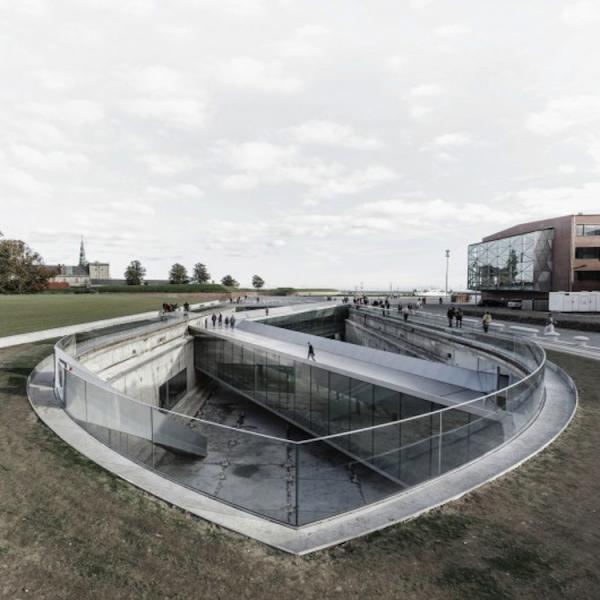The five finalists for the 2015 European Union Prize for Contemporary Architecture, or the Mies van der Rohe award. The finalists were chosen from a shortlist of 40 projects and include a sunken museum and a crystalline concert hall.
Considered to be some of the best works completed by European architects in the previous two years, the projects are in the running for a prize of more than $65,000.
The five finalists for the Mies van der Rohe award are:
- Philharmonic Hall Szczecin designed by Estudio Barozzi Veiga in Szczecin, Poland
- The Saw Swee Hock Student Centre by O'Donnell + Tuomey at the London School of Economics in London
- Ravensburg Art Museum designed by Lederer Ragnarsdóttir Oei in Ravensburg, Germany
- Danish Maritime Museum designed by Bjarke Ingels Group in Helsingør, Denmark
- Antinori Winter by Archea Associati in San Casciano Val di Pesa, Florence, Italy
The architects will present their projects to the jury on May 7.
 Philharmonic Hall Szczecin designed by Estudio Barozzi Veiga in Szczecin, Poland. Photo by Simon Menges
Philharmonic Hall Szczecin designed by Estudio Barozzi Veiga in Szczecin, Poland. Photo by Simon Menges
 The Saw Swee Hock Student Centre by O'Donnell + Tuomey at the London School of Economics in London. Photo by Alex Bland
The Saw Swee Hock Student Centre by O'Donnell + Tuomey at the London School of Economics in London. Photo by Alex Bland
 Ravensburg Art Museum designed by Lederer Ragnarsdóttir Oei in Ravensburg, Germany. Photo by Roland Halbe
Ravensburg Art Museum designed by Lederer Ragnarsdóttir Oei in Ravensburg, Germany. Photo by Roland Halbe
 Danish Maritime Museum desinged by Bjarke Ingels Group in Helsingør, Denmark. Photo by Rasmus Hjortshoj
Danish Maritime Museum desinged by Bjarke Ingels Group in Helsingør, Denmark. Photo by Rasmus Hjortshoj
 Antinori Winter by Archea Associati in San Casciano Val di Pesa, Florence, Italy. Photo by Pietro Savorelli
Antinori Winter by Archea Associati in San Casciano Val di Pesa, Florence, Italy. Photo by Pietro Savorelli
Related Stories
| Feb 6, 2012
Slight increase in nonres construction spending expected in 2012, growth projected for 2013
Commercial sector expected to lead real estate recovery.
| Feb 6, 2012
FMI releases 2012 Construction Productivity Report
Downsizing has resulted in retaining the most experienced and best-trained personnel who are the most capable of working more efficiently and harder.
| Feb 6, 2012
Kirchhoff-Consigli begins Phase 2 renovations at FDR Presidential Library and Museum
EYP Architecture & Engineering is architect for the $35 million National Archives Administration project.
| Feb 6, 2012
Batson-Cook announces the appointment of Hall as president
Hall will manage and direct all aspects of the firm’s day-to-day operations. He will be based in Batson-Cook’s Atlanta office.
| Feb 6, 2012
Siemens gifts Worcester Polytechnic Institute $100,000 for fire protection lab renovation
Siemens support is earmarked for the school’s Fire Protection Engineering Lab, a facility that has been forwarding engineering and other advanced degrees, graduating fire protection engineers since 1979.
| Feb 2, 2012
Call for Entries: 2012 Building Team Awards. Deadline March 2, 2012
Winning projects will be featured in the May issue of BD+C.
| Feb 2, 2012
VLK Architects selected for new Cypress, Texas elementary school
The Bridgeland Elementary School will be a new prototype school for the District. Designed to meet the requirements of The Collaborative for High Performance Schools.
| Feb 2, 2012
Mortenson Construction to build 2.4 MW solar project in North Carolina
Located on a 12 acre site in the Sandhills region, the 2.4 megawatt (MW) system is expected to generate approximately 3.5 million kilowatt hours (kWhs) of clean electricity on an annual basis.
| Feb 2, 2012
Shawmut Design and Construction launches sports venues division
Expansion caps year of growth for Shawmut.















